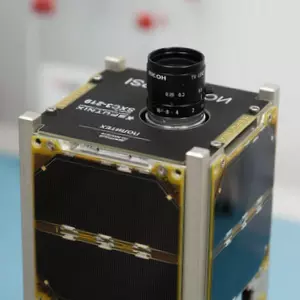The first domestic hyper-spectrometer for CubeSat-format nanosatellites, developed by scientists of Samara University and the RAS Image Processing System Institute (ISOI), successfully solved problems in course of testing in outer space, demonstrating its capabilities to obtain data used in the field of smart agriculture.
“During the flight tests currently taking place on board the SXC3-219 ISOI nanosatellite (3U nanosatellite format, U=10 x 10 x 10), our hyper-spectrometer has demonstrated its potential for promising application in the field of smart agriculture, which means that hyperspectral cameras of similar sizes and this design can be efficiently used in interests of the agricultural industry”, told us Roman Skidanov, Professor of the Department of Engineering Cybernetics at Samara University, Doctor of Physical and Mathematical Sciences. “Certainly, due to the nanosatellite compactness, data transmission to the Earth is conducted in the VHF band, which significantly reduces the amount and granularity of the data obtained, compared to those from large satellites”. Nevertheless, results of the four-month experiment in orbit confirm that this hyper-spectrometer allows us to obtain data to be quite sufficient to calculate the spectral vegetation indices used in farming for solving problems of smart agriculture”.
In total, there are more than 150 vegetation indices to be calculated on the basis of spectral data, show various plant parameters and properties necessary for agricultural producers to properly care for their crops. Depending on their condition, amounts of vitamins and moisture, ambient temperature and other factors, plants differently absorb and reflect electromagnetic waves in various ranges, and spectra. By comparing these data in the single complex with applying multi- or hyperspectral imaging, it is possible to remotely, quickly and more accurately assess the particular crop condition, without selectively sending individual plants or soil samples for laboratory analysis.
According to Roman Skidanov, images obtained in course of the experiment from the Samara hyper-spectrometer made it possible, for example, to identify areas of winter crops with the largest green mass, with high amount of chlorophyll, as well as to check farmlands that fell into the hyper-spectrometer lens for problematic crops. The data showed the level of moisture reserves in plants and helped to calculate the vegetation index that models the future productivity of plants, that is, gives the preliminary forecast of yield.
Another calculated index assessed the physiological condition of plants in terms of their stress. As it is known, plants are also subject to stress that can be caused by adverse phenomena – drought or overabundance of moisture, strong wind, temperature changes, sudden frosts, invasion of pest insects. Due to stress, metabolic changes occur in plants, and the hyper-spectrometer can detect them even from outer space.
“Hyperspectral data from a nanosatellite can be received independently, using VHF radio stations, or receive the data through the RAS Image Processing System Institute. Of course, it should be born in mind that this spacecraft equipped with the hyperspectral camera should be considered as the technology demonstrator to be followed by launches of more advanced, perhaps even serial, models of the compact hyper-spectrometer for CubeSats of various configurations. Moreover, this experiment is certainly important in terms of education: schoolchildren participating in the Space-Pi Program receive practical skills in processing space hyperspectral data”, emphasized Roman Skidanov.
About the hyper-spectrometer
The first domestic hyper-spectrometer for CubeSats is joint development of scientists from the RAS ISOI and Samara University. The device is being tested on board the SXC3-219 ISOI nanosatellite to be launched into orbit on August 9, 2022, as part of launching from the Baikonur cosmodrome the Soyuz-2.1b carrier rocket, with the Fregat upper stage with the Iranian “Khayyam” satellite and 16 Russian small spacecraft.
Though the satellite was launched as part of the Space-Pi (Space π) science-and-education project, the hyper-spectrometer installed on it is a full-fledged research device for hyperspectral remote sensing of the Earth, that is, performance of environmental monitoring, forest and agricultural crop condition monitoring, forest fire occurrence tracking, and implementing other tasks.
Previously, on domestic spacecraft of this class – nanosatellites of the CubeSat 3U format, hyper-spectrometers were not installed because of difficulties of creating the compact device with parameters required for hyperspectral shooting from outer space. Miniature hyper-spectrometers used, for example, for shooting from drones, are not suitable for shooting from orbit, therefore, space hyper-spectrometers are usually installed on relatively large Earth remote sensing satellites.
This hyper-spectrometer is developed on the basis of the Offner’s method. The device shoots in the visible and near infrared ranges. The number of spectral channels is from 150 to 300, spectral resolution is from 2 to 4 nm. The hyper-spectrometer mass is 1.6 kg, its dimensions are 13 x 9.4 x 9.4 cm, that is, it occupies less than half of the internal space of the CubeSat 3U nanosatellite with dimensions 10 x 10 x 30 cm.
For reference
* Space-Pi (Space π) is a science-and-education project for development and production of small CubeSat-format spacecrafts on domestic satellite platforms, aimed at forming a grouping of about 100 CubeSats 3U in orbit for several years, to create the infrastructure for involving schoolchildren in research and technical creativity in the field of space technologies.
** Samara University is one of the world leaders in the field of photonics. More than 40 years ago, the School of Computer Optics and Image Processing was established and successfully has been operating at the university, headed by Viktor Soyfer, Academician of the RAS and the President of Samara University. The University scientists have developed innovative diffraction optics, which has found its application in a variety of fields, such as outer space, medicine, agriculture.
Research in the field of diffraction optical elements made it possible for scientists of Samara University to created compact hyperspectral devices for applying them in smart agriculture. Mobile agroreclamation complexes are able to independently analyze the soil condition, and regulate intensity of irrigation and fertilization, which can increase crop yields by 25–30% in average.
 RU
RU  EN
EN  CN
CN  ES
ES 